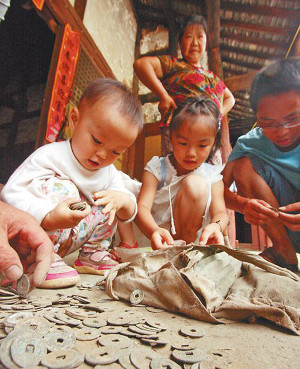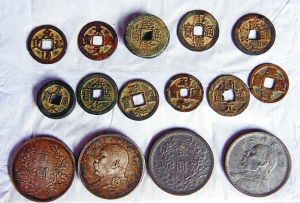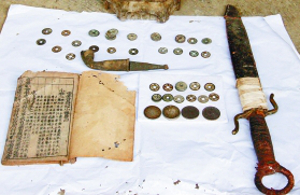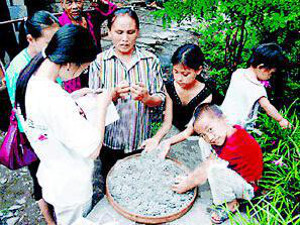
Children playing with ancient Chinese coins
A cute photograph of several young children sorting through ancient Chinese coins accompanied a newspaper article published in the Guiyang Evening News (guiyang wanbao 贵阳晚报) dated August 12, 2015.
Mr. Wang Pinli (王品礼) and his family live in a remote village in Meitan County (湄潭县) which is located in China’s southwest Guizhou Province (贵州省).
The coins, which were discovered buried on the family’s property, have become favorite toys for the children.
According to the newspaper article, rats had become a nuisance. There were several rat holes in the area between the kitchen and the ox pen.
Mr. Wang had filled in the hole with dirt where the rats had their nests but the rats kept returning.
In 1992, Mr. Wang finally decided to dig up the rat nests and completely fill in the holes.
While digging, he discovered a “money pit” 1.5 meters in diameter and 2 meters in depth which was filled with ancient Chinese coins. The “money pit” included coins from the Tang, Song, Ming and Qing dynasties.
There was more than 4,600 catties of coins which is equivalent to about 3 tons. Mr. Wang was able to sell the coins for 3-5 yuan (元) per catty which would be 13,800 – 23,000 RMB ($2,166 – $3,610).
This money was used to take care of the elder members of the family and to send the children to school.
Mr. Wang also decided to keep some of the coins.
The article mentioned some of these coins as being kai yuan tong bao (开元通宝), zheng he tong bao (正和通宝), wan li tong bao (万历通宝), hong wu tong bao (洪武通宝), shun zhi tong bao (顺治通宝), kang xi tong bao (康熙通宝), and qian long tong bao (乾隆通宝).
There is also mention of a coin from the Northern Wei (北魏朝) which could only be a tai he wu zhu (太和五铢).
A jing yuan tong bao (景元通宝) coin minted in 1377, which was minted in Annam (Vietnam) was also discovered.

Old Chinese coins discovered buried at the Guiyang home
Years later, Mr. Wang discovered even more coins buried on the property. This coin cache included more recent coins.
Some of these coins, shown in the image at the left, can be identified.
Top row (left to right):
- yuan you tong bao (元祐通宝) cast during the reign (1086-1100) of Emperor Zhe Zong of the Northern Song
- jing de yuan bao (景德元宝) cast during the years 998-1022 of the reign of Emperor Zhen Zong of the Northern Song
- qian long tong bao (乾隆通宝) cast during the reign (1736-1795) of the Qianlong Emperor of the Qing dynasty
- kang xi tong bao (康熙通宝) cast during the reign (1662-1722) of Emperor Sheng Zu of the Qing dynasty
- (image too small to identify)
Middle row (left to right):
- Japanese kanei tsuho (宽永通宝) coin cast during the years 1626-1867
- hong hua tong bao (洪化通宝) cast during the years 1679-1681 by the Southern Ming rebel Wu Shifan (吴世璠)
- zheng he tong bao (政和通宝) cast during the years 1111-1117 of the reign of Emperor Hui Zong of the Northern Song
- zheng he tong bao (政和通宝) cast during the years 1111-1117 of the reign of Emperor Hui Zong of the Northern Song
- kai yuan tong bao (开元通宝) cast during the Tang dynasty (618-846)
- (image too small to identify)
Bottom row (left to right):
- Yuan Shikai (“Fat Man Dollar”) silver dollar. These coins were minted beginning in 1914 during the Republic of China.
- Yuan Shikai (“Fat Man Dollar”) silver dollar.

Unearthed coin cache included a sword and copy of Book of Songs
Included in this coin cache was not only Japanese coins (宽永通宝) but also a 50 cm long sword and a copy of the Book of Songs (诗经).
According to a Chinese coin collector interviewed by the newspaper, the Japanese coins were cast beginning 400 years ago and circulated for about 240 years. The coins probably entered China during the late Ming and early Qing dynasties.
These Japanese coins are referred to as wo qian (倭钱) by the Chinese. The imperial court eventually prohibited these coins from entering the country.
The Wang family lives in a very remote and relatively poor mountainous area. They are not aware of any of their ancestors who were businessmen or government officials. It is a mystery who may have owned a sword, would have been in a position to obtain Japanese cash coins, or would have studied ancient Chinese texts such as the Book of Songs.
Mr. Wang can only speculate that one of the ancestors may have been a small-scale businessman who may have worked in a coastal area since that would have been the only place the Japanese coins may have circulated after the imperial court banned their entry into the county.
Still, the children are just happy to play with their “toys” and are not concerned with the mystery of their origin.
The children are not always careful with their “toys”, however, and the coins can be found scattered throughout the house.

More than 4,000 ancient Chinese coins discovered buried in Qianjiang District
Another article involving a cute image of “young numismatists” (coin collectors) was published on September 15, 2015 by the major Chinese internet company Sohu, Inc. (搜狐).
Ms. Wang Meiying (王美英) lives in Qianjiang District (黔江区).
On August 1, 2015, she was collecting wood in the mountain area where she lives.
Unexpectedly, she discovered a hole in which a large quantity of old coins were buried.
The coins weighed about 30 catties which would be more than 4,000 coins.
About 80% of the coins are from the Qing dynasty (1644-1911) including coins frequently found in that area such as kang xi tong bao (康熙通宝), qian long tong bao (乾隆通宝), and xian feng tong bao (咸丰通宝).
Coins from earlier dynasties were found as well. Tang dynasty kai yuan tong bao (开元通宝) coins as well as Song dynasty coins such as jing de yuan bao (景德元宝) and yuan feng tong bao (元丰通宝) were discovered in the hoard. Chong zhen tong bao (崇祯通宝) coins from the Ming dynasty were also found.
The reporter estimated that the coins cover a period of about 1400 years.
According to Ms. Wan Jixiang (万继湘), a 75 year old local villager, this area did not use cash coins in the past and there were no landlords or government officials who lived here who could have accumulated so much money.
Because this remote mountain area has a long history of banditry, some of the villagers speculate that the money may have been buried long ago by bandits (tu fei 土匪) on the run.